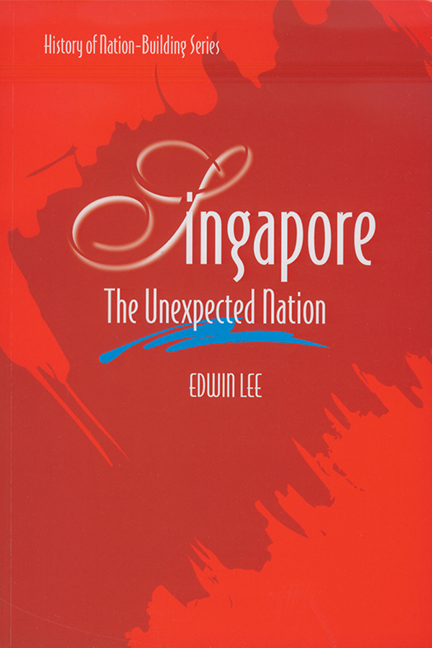Book contents
- Frontmatter
- Dedication
- Contents
- Preface
- Introduction by Wang Gungwu
- Chapter One Beginnings: From Temasek to Singapore
- Chapter Two Race, History and Nationalism
- Chapter Three Contestants and Contesting Visions
- Chapter Four The Accidental Chief Minister
- Chapter Five The Terminal Chief Minister
- Chapter Six The Embattled Prime Minister
- Chapter Seven Merger: Contesting Ownership and Principles
- Chapter Eight Terms of Disendearment
- Chapter Nine Dare to be Equal
- Chapter Ten The Way to Survive
- Chapter Eleven National Service: The Price of Independence
- Chapter Twelve Politics of Education
- Chapter Thirteen Home Ownership, National Stability and the New Middle Classes
- Chapter Fourteen University and Nation
- Chapter Fifteen Toh's Nation-Building Thrust
- Chapter Sixteen Nantah: Between Community and Nation
- Chapter Seventeen Self-Renewal: Talents for a Tough Act
- Chapter Eighteen The Consensual Prime Minister
- Chapter Nineteen Confucianism, Christianity, Chineseness
- Chapter Twenty Singapore Dreams, Singapore Dilemmas
- Chapter Twenty-One The Hyphenated Singaporean
- Chapter Twenty-Two The Unexpected Nation
- Bibliographical Note
- Index
- The Author
Introduction by Wang Gungwu
Published online by Cambridge University Press: 21 October 2015
- Frontmatter
- Dedication
- Contents
- Preface
- Introduction by Wang Gungwu
- Chapter One Beginnings: From Temasek to Singapore
- Chapter Two Race, History and Nationalism
- Chapter Three Contestants and Contesting Visions
- Chapter Four The Accidental Chief Minister
- Chapter Five The Terminal Chief Minister
- Chapter Six The Embattled Prime Minister
- Chapter Seven Merger: Contesting Ownership and Principles
- Chapter Eight Terms of Disendearment
- Chapter Nine Dare to be Equal
- Chapter Ten The Way to Survive
- Chapter Eleven National Service: The Price of Independence
- Chapter Twelve Politics of Education
- Chapter Thirteen Home Ownership, National Stability and the New Middle Classes
- Chapter Fourteen University and Nation
- Chapter Fifteen Toh's Nation-Building Thrust
- Chapter Sixteen Nantah: Between Community and Nation
- Chapter Seventeen Self-Renewal: Talents for a Tough Act
- Chapter Eighteen The Consensual Prime Minister
- Chapter Nineteen Confucianism, Christianity, Chineseness
- Chapter Twenty Singapore Dreams, Singapore Dilemmas
- Chapter Twenty-One The Hyphenated Singaporean
- Chapter Twenty-Two The Unexpected Nation
- Bibliographical Note
- Index
- The Author
Summary
The Series
This series of histories on nation-building in Southeast Asia had its beginnings in Bangkok at the 14th Conference of the International Association of the Historians of Asia (IAHA). At that meeting, I noted that nation-building in Southeast Asia began fifty years ago and suggested that it was time for historians to write about that phenomenon. Most books on the region's new nations have been written by journalists and social scientists. I asked whether historians would tell the story differently. Decades of anti-colonial nationalism came to a climax with the Japanese invasion of 1941–45. New states like those of the Philippines, Indonesia and Burma were born immediately after the war, followed soon by those of Malaysia and Singapore. The independence of a unified Vietnam was delayed by a bitter war and this held back the liberation of the two other Indochina states, Cambodia and Laos, but the independence of all three was only a matter of time.
Many of the protagonists of the early phases of nation-building have described their roles in this new process. Political commentators and journalists provided up-to-date accounts and analyses. But historians of the region have been concerned not to write prematurely about this subject. Many were, like me, fascinated by the first generation of nationalist leaders, men like Sukarno, Tengku Abdul Rahman and Ho Chi Minh, followed by Lee Kuan Yew, Soeharto, Ferdinand Marcos and Ne Win, but hesitant to take on full-length studies about the nations they had set out to build. Through their leadership, their peoples were offered sharply distinct visions of their countries’ future. Would historians wait, as they are wont to do, for all sources to be available before they began research on their countries? How long would it be before the story of each country in Southeast Asia is told by the historians themselves?
When I returned from the Bangkok conference, I brought the question to the Institute of Southeast Asian Studies (lSEAS) and was gratified when the then director, Professor Chan Heng Chee, encouraged me to try and find out. With that support, I approached five of the leading historians of the original members of the Association of Southeast Asian Nations (ASEAN in 1968 consisted of Indonesia, Thailand, Philippines, Malaysia and Singapore). They were Taufik Abdullah, Charnvit Kasetsiri, Reynaldo Ileto, Cheah Boon Kheng and Edwin Lee.
- Type
- Chapter
- Information
- SingaporeThe Unexpected Nation, pp. xv - xxiiPublisher: ISEAS–Yusof Ishak InstitutePrint publication year: 2008

